Africa
Africa is the world's second-largest and second-most populous continent, after Asia. At about 30.3 million km2 (11.7 million square miles) including adjacent islands, it covers 6% of Earth's total surface area and 20% of its land area.[4] With 1.3 billion people[1][2] as of 2018, it accounts for about 16% of the world's human population. Africa's average population is the youngest amongst all the continents;[5][6] the median age in 2012 was 19.7, when the worldwide median age was 30.4.[7] Despite a wide range of natural resources, the continent is the least wealthy per capita, possibly due in part to the legacies of European colonization in Africa. Despite this low concentration of wealth, recent economic expansion and the large and young population make Africa an important economic market in the broader global context.
.svg.png) _blank.svg.png) | |
| Area | 30,370,000 km2 (11,730,000 sq mi) (2nd) |
|---|---|
| Population | 1,275,920,972[1][2] (2018; 2nd) |
| Population density | 36.4/km2 (94/sq mi) |
| GDP (PPP) | $7.16 trillion (2019; 5th)[3] |
| GDP (nominal) | $2.45 trillion (2019; 5th)[3] |
| GDP per capita | $1,930 (2019; 6th)[3] |
| Demonym | African |
| Countries | 54+2 (disputed) |
| Dependencies | External (3)
|
| Languages | 1250–3000 native languages |
| Time zones | UTC-1 to UTC+4 |
| Largest cities | Largest urban areas: |
The continent is surrounded by the Mediterranean Sea to the north, the Isthmus of Suez and the Red Sea to the northeast, the Indian Ocean to the southeast and the Atlantic Ocean to the west. The continent includes Madagascar and various archipelagos. It contains 54 fully recognised sovereign states (countries), eight territories and two de facto independent states with limited or no recognition. Algeria is Africa's largest country by area, and Nigeria is its largest by population. African nations cooperate through the establishment of the African Union, which is headquartered in Addis Ababa.
Africa straddles the Equator and encompasses numerous climate areas; it is the only continent to stretch from the northern temperate to southern temperate zones.[8] The majority of the continent and its countries are in the Northern Hemisphere, with a substantial portion and number of countries in the Southern Hemisphere. Africa is home to much biodiversity; it is the continent with the largest number of megafauna species, as it was least affected by the extinction of the Pleistocene megafauna. However, Africa also is heavily affected by a wide range of environmental issues, including desertification, deforestation, water scarcity, and other issues. These entrenched environmental concerns are expected to worsen as climate change impacts Africa. The UN Intergovernmental Panel on Climate Change has identified Africa as the most vulnerable continent to climate change.[9][10]
Africa, particularly Eastern Africa, is widely accepted as the place of origin of humans and the Hominidae clade (great apes), meaning that Africa has a long and complex history. The earliest hominids and their ancestors have been dated to around 7 million years ago, including Sahelanthropus tchadensis, Australopithecus africanus, A. afarensis, Homo erectus, H. habilis and H. ergaster— the earliest Homo sapiens (modern human) remains, found in Ethiopia, South Africa, and Morocco, date to circa 200,000, 259,000, and 300,000 years ago respectively, and Homo sapiens is believed to have orignated in Africa around 350,000-260,000 years ago.[11][12][13][14][15] Early human civilizations, such as Ancient Egypt and Phoenicia emerged in North Africa. Following a subsequent long and complex history of civilizations, migration and trade, Africa hosts a large diversity of ethnicities, cultures and languages. The last 400 years have witnessed an increasing European influence on the continent. Starting in the 16th century, this was driven by trade, including the Trans-Atlantic slave trade, which created large African diaspora populations in the Americas. In the late 19th century, European countries colonized almost all of Africa, extracting resources from the continent and exploiting local communities; most present states in Africa emerged from a process of decolonisation in the 20th century.
Etymology

Afri was a Latin name used to refer to the inhabitants of then-known northern Africa to the west of the Nile river, and in its widest sense referred to all lands south of the Mediterranean (Ancient Libya).[16][17] This name seems to have originally referred to a native Libyan tribe, an ancestor of modern Berbers; see Terence for discussion. The name had usually been connected with the Phoenician word ʿafar meaning "dust",[18] but a 1981 hypothesis[19] has asserted that it stems from the Berber word ifri (plural ifran) meaning "cave", in reference to cave dwellers.[20] The same word[20] may be found in the name of the Banu Ifran from Algeria and Tripolitania, a Berber tribe originally from Yafran (also known as Ifrane) in northwestern Libya.[21]
Under Roman rule, Carthage became the capital of the province it then named Africa Proconsularis, following its defeat of the Carthaginians in the Third Punic War in 146 BC, which also included the coastal part of modern Libya.[22] The Latin suffix -ica can sometimes be used to denote a land (e.g., in Celtica from Celtae, as used by Julius Caesar). The later Muslim region of Ifriqiya, following its conquest of the Byzantine (Eastern Roman) Empire's Exarchatus Africae, also preserved a form of the name.
According to the Romans, Africa lay to the west of Egypt, while "Asia" was used to refer to Anatolia and lands to the east. A definite line was drawn between the two continents by the geographer Ptolemy (85–165 AD), indicating Alexandria along the Prime Meridian and making the isthmus of Suez and the Red Sea the boundary between Asia and Africa. As Europeans came to understand the real extent of the continent, the idea of "Africa" expanded with their knowledge.
Other etymological hypotheses have been postulated for the ancient name "Africa":
- The 1st-century Jewish historian Flavius Josephus (Ant. 1.15) asserted that it was named for Epher, grandson of Abraham according to Gen. 25:4, whose descendants, he claimed, had invaded Libya.
- Isidore of Seville in his 7th-century Etymologiae XIV.5.2. suggests "Africa comes from the Latin aprica, meaning "sunny".
- Massey, in 1881, stated that Africa is derived from the Egyptian af-rui-ka, meaning "to turn toward the opening of the Ka." The Ka is the energetic double of every person and the "opening of the Ka" refers to a womb or birthplace. Africa would be, for the Egyptians, "the birthplace."[23]
- Michèle Fruyt in 1976 proposed[24] linking the Latin word with africus "south wind", which would be of Umbrian origin and mean originally "rainy wind".
- Robert R. Stieglitz of Rutgers University in 1984 proposed: "The name Africa, derived from the Latin *Aphir-ic-a, is cognate to Hebrew Ophir."[25]
- Ibn Khallikan and some other historians claim that the name of Africa came from a Himyarite king called Afrikin ibn Kais ibn Saifi also called "Afrikus son of Abrahah" who subdued Ifriqiya.[26][27][28]
History
Prehistory
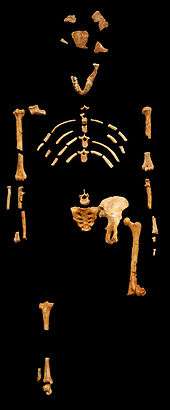
Africa is considered by most paleoanthropologists to be the oldest inhabited territory on Earth, with the human species originating from the continent.[29][30] During the mid-20th century, anthropologists discovered many fossils and evidence of human occupation perhaps as early as 7 million years ago (BP=before present). Fossil remains of several species of early apelike humans thought to have evolved into modern man, such as Australopithecus afarensis (radiometrically dated to approximately 3.9–3.0 million years BP,[31] Paranthropus boisei (c. 2.3–1.4 million years BP)[32] and Homo ergaster (c. 1.9 million–600,000 years BP) have been discovered.[4]
After the evolution of Homo sapiens approximately 350,000 to 260,000 years BP in Africa.[12][13][14][15] the continent was mainly populated by groups of hunter-gatherers.[33][34][35] These first modern humans left Africa and populated the rest of the globe during the Out of Africa II migration dated to approximately 50,000 years BP, exiting the continent either across Bab-el-Mandeb over the Red Sea,[36][37] the Strait of Gibraltar in Morocco,[38][39] or the Isthmus of Suez in Egypt.[40]
Other migrations of modern humans within the African continent have been dated to that time, with evidence of early human settlement found in Southern Africa, Southeast Africa, North Africa, and the Sahara.[41]
The size of the Sahara has historically been extremely variable, with its area rapidly fluctuating and at times disappearing depending on global climatic conditions.[42] At the end of the Ice ages, estimated to have been around 10,500 BC, the Sahara had again become a green fertile valley, and its African populations returned from the interior and coastal highlands in Sub-Saharan Africa, with rock art paintings depicting a fertile Sahara and large populations discovered in Tassili n'Ajjer dating back perhaps 10 millennia.[43] However, the warming and drying climate meant that by 5000 BC, the Sahara region was becoming increasingly dry and hostile. Around 3500 BC, due to a tilt in the earth's orbit, the Sahara experienced a period of rapid desertification.[44] The population trekked out of the Sahara region towards the Nile Valley below the Second Cataract where they made permanent or semi-permanent settlements. A major climatic recession occurred, lessening the heavy and persistent rains in Central and Eastern Africa. Since this time, dry conditions have prevailed in Eastern Africa and, increasingly during the last 200 years, in Ethiopia.
The domestication of cattle in Africa preceded agriculture and seems to have existed alongside hunter-gatherer cultures. It is speculated that by 6000 BC, cattle were domesticated in North Africa.[45] In the Sahara-Nile complex, people domesticated many animals, including the donkey and a small screw-horned goat which was common from Algeria to Nubia.
Around 4000 BC, the Saharan climate started to become drier at an exceedingly fast pace.[46] This climate change caused lakes and rivers to shrink significantly and caused increasing desertification. This, in turn, decreased the amount of land conducive to settlements and helped to cause migrations of farming communities to the more tropical climate of West Africa.[46]
By the first millennium BC, ironworking had been introduced in Northern Africa and around that time also became established in parts of sub-Saharan Africa either through independent invention there or diffusion from the north[47] and by 500 BC, metalworking began to become commonplace in West Africa. Ironworking was fully established by roughly 500 BC in many areas of East and West Africa, although other regions didn't begin ironworking until the early centuries AD. Copper objects from Egypt, North Africa, Nubia, and Ethiopia dating from around 500 BC have been excavated in West Africa, suggesting that Trans-Saharan trade networks had been established by this date.[46]
Early civilizations
.jpg)
At about 3300 BC, the historical record opens in Northern Africa with the rise of literacy in the Pharaonic civilization of Ancient Egypt.[48] One of the world's earliest and longest-lasting civilizations, the Egyptian state continued, with varying levels of influence over other areas, until 343 BC.[49][50] Egyptian influence reached deep into modern-day Libya and Nubia, and, according to Martin Bernal, as far north as Crete.[51]
An independent centre of civilization with trading links to Phoenicia was established by Phoenicians from Tyre on the north-west African coast at Carthage.[52][53][54]
European exploration of Africa began with Ancient Greeks and Romans.[55][56] In 332 BC, Alexander the Great was welcomed as a liberator in Persian-occupied Egypt. He founded Alexandria in Egypt, which would become the prosperous capital of the Ptolemaic dynasty after his death.[57]
Following the conquest of North Africa's Mediterranean coastline by the Roman Empire, the area was integrated economically and culturally into the Roman system. Roman settlement occurred in modern Tunisia and elsewhere along the coast. The first Roman emperor native to North Africa was Septimius Severus, born in Leptis Magna in present-day Libya—his mother was Italian Roman and his father was Punic.[58]
Christianity spread across these areas at an early date, from Judaea via Egypt and beyond the borders of the Roman world into Nubia;[59] by AD 340 at the latest, it had become the state religion of the Aksumite Empire. Syro-Greek missionaries, who arrived by way of the Red Sea, were responsible for this theological development.[60]
In the early 7th century, the newly formed Arabian Islamic Caliphate expanded into Egypt, and then into North Africa. In a short while, the local Berber elite had been integrated into Muslim Arab tribes. When the Umayyad capital Damascus fell in the 8th century, the Islamic centre of the Mediterranean shifted from Syria to Qayrawan in North Africa. Islamic North Africa had become diverse, and a hub for mystics, scholars, jurists, and philosophers. During the above-mentioned period, Islam spread to sub-Saharan Africa, mainly through trade routes and migration.[61]
In West Africa, Dhar Tichitt and Oualata in present-day Mauritania figure prominently among the early urban centers, dated to 2,000 BC. About 500 stone settlements litter the region in the former savannah of the Sahara. Its inhabitants fished and grew millet. It has been found by Augustin Holl that the Soninke of the Mandé peoples were likely responsible for constructing such settlements. Around 300 BC the region became more desiccated and the settlements began to decline, most likely relocating to Koumbi Saleh.[62] Architectural evidence and the comparison of pottery styles suggest that Dhar Tichitt was related to the subsequent Ghana Empire. Djenné-Djenno (in present-day Mali) was settled around 300 BC, and the town grew to house a sizable Iron Age population, as evidenced by crowded cemeteries. Living structures were made of sun-dried mud. By 250 BC Djenné-Djenno had become a large, thriving market town.[63][64]
Farther south, in central Nigeria, around 1,000 BC, the Nok culture developed on the Jos Plateau. It was a highly centralized community. The Nok people produced lifelike representations in terracotta, including human heads and human figures, elephants, and other animals. By 500 BC they were smelting iron. By 200 AD the Nok culture had vanished. Based on stylistic similarities with the Nok terracottas, the bronze figurines of the Yoruba kingdom of Ife and those of the Bini kingdom of Benin are now believed to be continuations of the traditions of the earlier Nok culture.[65]
Ninth to eighteenth centuries
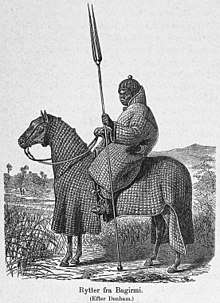
Pre-colonial Africa possessed perhaps as many as 10,000 different states and polities[67] characterized by many different sorts of political organization and rule. These included small family groups of hunter-gatherers such as the San people of southern Africa; larger, more structured groups such as the family clan groupings of the Bantu-speaking peoples of central, southern, and eastern Africa; heavily structured clan groups in the Horn of Africa; the large Sahelian kingdoms; and autonomous city-states and kingdoms such as those of the Akan; Edo, Yoruba, and Igbo people in West Africa; and the Swahili coastal trading towns of Southeast Africa.
By the ninth century AD, a string of dynastic states, including the earliest Hausa states, stretched across the sub-Saharan savannah from the western regions to central Sudan. The most powerful of these states were Ghana, Gao, and the Kanem-Bornu Empire. Ghana declined in the eleventh century, but was succeeded by the Mali Empire which consolidated much of western Sudan in the thirteenth century. Kanem accepted Islam in the eleventh century.
In the forested regions of the West African coast, independent kingdoms grew with little influence from the Muslim north. The Kingdom of Nri was established around the ninth century and was one of the first. It is also one of the oldest kingdoms in present-day Nigeria and was ruled by the Eze Nri. The Nri kingdom is famous for its elaborate bronzes, found at the town of Igbo-Ukwu. The bronzes have been dated from as far back as the ninth century.[68]
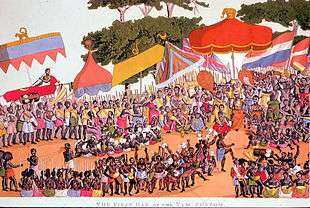
The Kingdom of Ife, historically the first of these Yoruba city-states or kingdoms, established government under a priestly oba ('king' or 'ruler' in the Yoruba language), called the Ooni of Ife. Ife was noted as a major religious and cultural centre in West Africa, and for its unique naturalistic tradition of bronze sculpture. The Ife model of government was adapted at the Oyo Empire, where its obas or kings, called the Alaafins of Oyo, once controlled a large number of other Yoruba and non-Yoruba city-states and kingdoms; the Fon Kingdom of Dahomey was one of the non-Yoruba domains under Oyo control.
The Almoravids were a Berber dynasty from the Sahara that spread over a wide area of northwestern Africa and the Iberian peninsula during the eleventh century.[69] The Banu Hilal and Banu Ma'qil were a collection of Arab Bedouin tribes from the Arabian Peninsula who migrated westwards via Egypt between the eleventh and thirteenth centuries. Their migration resulted in the fusion of the Arabs and Berbers, where the locals were Arabized,[70] and Arab culture absorbed elements of the local culture, under the unifying framework of Islam.[71]
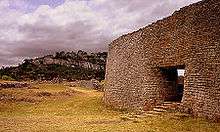
Following the breakup of Mali, a local leader named Sonni Ali (1464–1492) founded the Songhai Empire in the region of middle Niger and the western Sudan and took control of the trans-Saharan trade. Sonni Ali seized Timbuktu in 1468 and Jenne in 1473, building his regime on trade revenues and the cooperation of Muslim merchants. His successor Askia Mohammad I (1493–1528) made Islam the official religion, built mosques, and brought to Gao Muslim scholars, including al-Maghili (d.1504), the founder of an important tradition of Sudanic African Muslim scholarship.[72] By the eleventh century, some Hausa states – such as Kano, jigawa, Katsina, and Gobir – had developed into walled towns engaging in trade, servicing caravans, and the manufacture of goods. Until the fifteenth century, these small states were on the periphery of the major Sudanic empires of the era, paying tribute to Songhai to the west and Kanem-Borno to the east.
_1803.jpg)
Mansa Musa ruled the Mali Empire in the 14th century.
Height of the slave trade
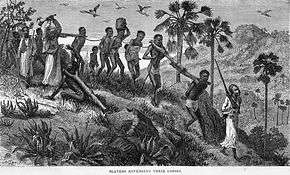
Slavery had long been practiced in Africa.[73][74] Between the 7th and 20th centuries, the Arab slave trade (also known as "slavery in the east") took 18 million slaves from Africa via trans-Saharan and Indian Ocean routes. Between the 15th and the 19th centuries, the Atlantic slave trade took an estimated 7–12 million slaves to the New World.[75][76][77] In addition, more than 1 million Europeans were captured by Barbary pirates and sold as slaves in North Africa between the 16th and 19th centuries.[78]
In West Africa, the decline of the Atlantic slave trade in the 1820s caused dramatic economic shifts in local polities. The gradual decline of slave-trading, prompted by a lack of demand for slaves in the New World, increasing anti-slavery legislation in Europe and America, and the British Royal Navy's increasing presence off the West African coast, obliged African states to adopt new economies. Between 1808 and 1860, the British West Africa Squadron seized approximately 1,600 slave ships and freed 150,000 Africans who were aboard.[79]
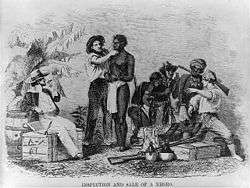
Action was also taken against African leaders who refused to agree to British treaties to outlaw the trade, for example against "the usurping King of Lagos", deposed in 1851. Anti-slavery treaties were signed with over 50 African rulers.[80] The largest powers of West Africa (the Asante Confederacy, the Kingdom of Dahomey, and the Oyo Empire) adopted different ways of adapting to the shift. Asante and Dahomey concentrated on the development of "legitimate commerce" in the form of palm oil, cocoa, timber and gold, forming the bedrock of West Africa's modern export trade. The Oyo Empire, unable to adapt, collapsed into civil wars.[81]
Colonialism and the "Scramble for Africa"
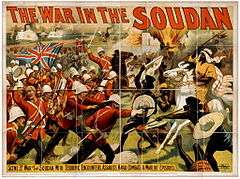
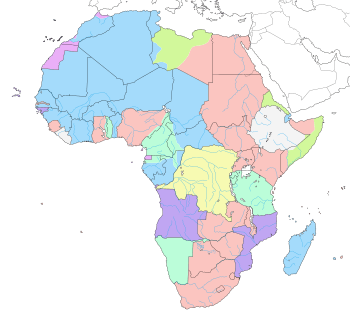
The Scramble for Africa, also called the Partition of Africa or the Conquest of Africa, was the invasion, occupation, division, and colonisation of African territory by European powers during a short period known to historians as the New Imperialism (between 1881 and 1914). In 1870, only 10 percent of Africa was under formal European control; by 1914 this had increased to almost 90 percent of the continent, with only Ethiopia (Abyssinia) and Liberia remaining independent, and the latter was a former United States colony. The European colonialists had several motives: a desire for valuable natural resources, the quest for national prestige, rivalry between European powers, and religious missionary zeal. Internal African native politics also played a role.
The Berlin Conference of 1884, which regulated European colonisation and trade in Africa, is usually referred to as the starting point of the Scramble for Africa.[82] Consequent to the political and economic rivalries among the European empires in the last quarter of the 19th century, partitioning Africa was how the Europeans avoided going to war over it.[83] In the later years of the 19th century, the European nations transitioned from "informal imperialism" — i.e., exercising military influence and economic dominance — to direct rule, bringing about colonial imperialism.[84]Independence struggles
Imperial rule by Europeans would continue until after the conclusion of World War II, when almost all remaining colonial territories gradually obtained formal independence. Independence movements in Africa gained momentum following World War II, which left the major European powers weakened. In 1951, Libya, a former Italian colony, gained independence. In 1956, Tunisia and Morocco won their independence from France.[85] Ghana followed suit the next year (March 1957),[86] becoming the first of the sub-Saharan colonies to be granted independence. Most of the rest of the continent became independent over the next decade.
Portugal's overseas presence in Sub-Saharan Africa (most notably in Angola, Cape Verde, Mozambique, Guinea-Bissau and São Tomé and Príncipe) lasted from the 16th century to 1975, after the Estado Novo regime was overthrown in a military coup in Lisbon. Rhodesia unilaterally declared independence from the United Kingdom in 1965, under the white minority government of Ian Smith, but was not internationally recognized as an independent state (as Zimbabwe) until 1980, when black nationalists gained power after a bitter guerrilla war. Although South Africa was one of the first African countries to gain independence, the state remained under the control of the country's white minority through a system of racial segregation known as apartheid until 1994.
Post-colonial Africa
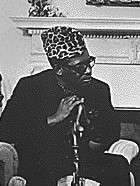
Today, Africa contains 54 sovereign countries, most of which have borders that were drawn during the era of European colonialism. Since colonialism, African states have frequently been hampered by instability, corruption, violence, and authoritarianism. The vast majority of African states are republics that operate under some form of the presidential system of rule. However, few of them have been able to sustain democratic governments on a permanent basis, and many have instead cycled through a series of coups, producing military dictatorships.
Great instability was mainly the result of marginalization of ethnic groups, and graft under these leaders. For political gain, many leaders fanned ethnic conflicts, some of which had been exacerbated, or even created, by colonial rule. In many countries, the military was perceived as being the only group that could effectively maintain order, and it ruled many nations in Africa during the 1970s and early 1980s. During the period from the early 1960s to the late 1980s, Africa had more than 70 coups and 13 presidential assassinations. Border and territorial disputes were also common, with the European-imposed borders of many nations being widely contested through armed conflicts.
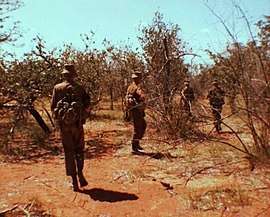
Cold War conflicts between the United States and the Soviet Union, as well as the policies of the International Monetary Fund,[87] also played a role in instability. When a country became independent for the first time, it was often expected to align with one of the two superpowers. Many countries in Northern Africa received Soviet military aid, while others in Central and Southern Africa were supported by the United States, France or both. The 1970s saw an escalation of Cold War intrigues, as newly independent Angola and Mozambique aligned themselves with the Soviet Union, and the West and South Africa sought to contain Soviet influence by supporting friendly regimes or insurgency movements. In Rhodesia, Soviet and Chinese-backed leftist guerrillas of the Zimbabwe Patriotic Front waged a brutal guerrilla war against the country's white government. There was a major famine in Ethiopia, when hundreds of thousands of people starved. Some claimed that Marxist economic policies made the situation worse.[88][89][90] The most devastating military conflict in modern independent Africa has been the Second Congo War; this conflict and its aftermath has killed an estimated 5.5 million people.[91] Since 2003 there has been an ongoing conflict in Darfur which has become a humanitarian disaster. Another notable tragic event is the 1994 Rwandan genocide in which an estimated 800,000 people were murdered. AIDS in post-colonial Africa has also been a prevalent issue.
In the 21st century, however, the number of armed conflicts in Africa has steadily declined. For instance, the civil war in Angola came to an end in 2002 after nearly 30 years. This coincided with many countries abandoning communist-style command economies and opening up for market reforms. The improved stability and economic reforms have led to a great increase in foreign investment into many African nations, mainly from China,[92] which has spurred quick economic growth in many countries, seemingly ending decades of stagnation and decline. Several African economies are among the world's fastest growing as of 2016. A significant part of this growth, which is sometimes referred to as Africa Rising, can also be attributed to the facilitated diffusion of information technologies and specifically the mobile telephone.[93] Migration from African nations has increased dramatically in the last decade.[94]
Geology and geography

Africa is the largest of the three great southward projections from the largest landmass of the Earth. Separated from Europe by the Mediterranean Sea, it is joined to Asia at its northeast extremity by the Isthmus of Suez (transected by the Suez Canal), 163 km (101 mi) wide.[95] (Geopolitically, Egypt's Sinai Peninsula east of the Suez Canal is often considered part of Africa, as well.)[96]
The coastline is 26,000 km (16,000 mi) long, and the absence of deep indentations of the shore is illustrated by the fact that Europe, which covers only 10,400,000 km2 (4,000,000 sq mi) – about a third of the surface of Africa – has a coastline of 32,000 km (20,000 mi).[97] From the most northerly point, Ras ben Sakka in Tunisia (37°21' N), to the most southerly point, Cape Agulhas in South Africa (34°51'15" S), is a distance of approximately 8,000 km (5,000 mi).[98] Cape Verde, 17°33'22" W, the westernmost point, is a distance of approximately 7,400 km (4,600 mi) to Ras Hafun, 51°27'52" E, the most easterly projection that neighbours Cape Guardafui, the tip of the Horn of Africa.[97]
Africa's largest country is Algeria, and its smallest country is Seychelles, an archipelago off the east coast.[99] The smallest nation on the continental mainland is The Gambia.
African plate
| Africa | |
|---|---|
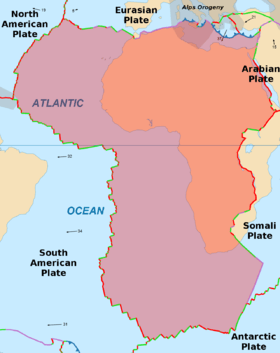 | |
| Type | Major |
| Approximate area | 61,300,000 km2 (23,700,000 sq mi)[100] |
| Features | Africa, Atlantic Ocean, Mediterranean Sea |
The African Plate is a major tectonic plate straddling the equator as well as the prime meridian. It includes much of the continent of Africa, as well as oceanic crust which lies between the continent and various surrounding ocean ridges. Between 60 million years ago and 10 million years ago, the Somali Plate began rifting from the African Plate along the East African Rift.[101] Since the continent of Africa consists of crust from both the African and the Somali plates, some literature refers to the African Plate as the Nubian Plate to distinguish it from the continent as a whole.[102]
Geologically, Africa includes the Arabian Peninsula; the Zagros Mountains of Iran and the Anatolian Plateau of Turkey mark where the African Plate collided with Eurasia. The Afrotropical realm and the Saharo-Arabian desert to its north unite the region biogeographically, and the Afro-Asiatic language family unites the north linguistically.
Climate
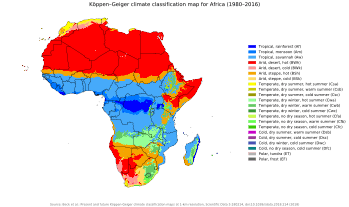
The climate of Africa ranges from tropical to subarctic on its highest peaks. Its northern half is primarily desert, or arid, while its central and southern areas contain both savanna plains and dense jungle (rainforest) regions. In between, there is a convergence, where vegetation patterns such as sahel and steppe dominate. Africa is the hottest continent on Earth and 60% of the entire land surface consists of drylands and deserts.[104] The record for the highest-ever recorded temperature, in Libya in 1922 (58 °C (136 °F)), was discredited in 2013.[105][106]
Fauna
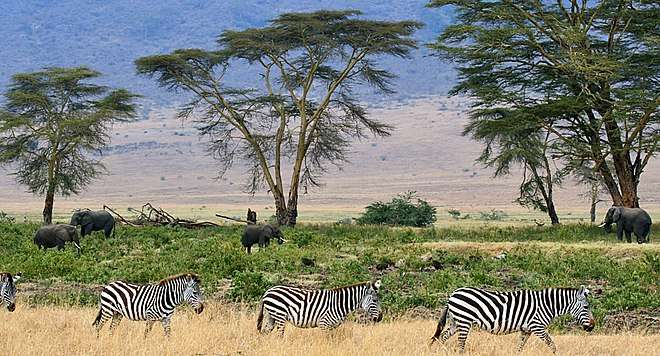
Africa boasts perhaps the world's largest combination of density and "range of freedom" of wild animal populations and diversity, with wild populations of large carnivores (such as lions, hyenas, and cheetahs) and herbivores (such as buffalo, elephants, camels, and giraffes) ranging freely on primarily open non-private plains. It is also home to a variety of "jungle" animals including snakes and primates and aquatic life such as crocodiles and amphibians. In addition, Africa has the largest number of megafauna species, as it was least affected by the extinction of the Pleistocene megafauna.
Ecology and biodiversity

Africa has over 3,000 protected areas, with 198 marine protected areas, 50 biosphere reserves, and 80 wetlands reserves. Significant habitat destruction, increases in human population and poaching are reducing Africa's biological diversity and arable land. Human encroachment, civil unrest and the introduction of non-native species threaten biodiversity in Africa. This has been exacerbated by administrative problems, inadequate personnel and funding problems.[104]
Deforestation is affecting Africa at twice the world rate, according to the United Nations Environment Programme (UNEP).[107] According to the University of Pennsylvania African Studies Center, 31% of Africa's pasture lands and 19% of its forests and woodlands are classified as degraded, and Africa is losing over four million hectares of forest per year, which is twice the average deforestation rate for the rest of the world.[104] Some sources claim that approximately 90% of the original, virgin forests in West Africa have been destroyed.[108] Over 90% of Madagascar's original forests have been destroyed since the arrival of humans 2000 years ago.[109] About 65% of Africa's agricultural land suffers from soil degradation.[110]
Environmental issues
Climate change

Anthropogenic climate change is already a reality in Africa, as it is elsewhere in the world. According to the Intergovernmental Panel on Climate Change, Africa is among the most vulnerable continents to climate change.[112][113] The vulnerability of Africa to climate change is driven by a range of factors that includes weak adaptive capacity, high dependence on ecosystem goods for livelihoods, and less developed agricultural production systems.[114] The risks of climate change on agricultural production, food security, water resources and ecosystem services will likely have increasingly severe consequences on lives and sustainable development prospects in Africa.[115] Managing this risk requires integration of mitigation and adaptation strategies in the management of ecosystem goods and services, and the agriculture production systems in Africa.[116]
Over the coming decades, warming from climate change is expected across almost all the earth's surface, and global mean rainfall will increase.[117] Regional effects on rainfall in the tropics are expected to be much more spatially variable and the sign of change at any one location is often less certain, although changes are expected. Consistent with this, observed surface temperatures have generally increased over Africa since the late 19th century to the early 21st century by about 1 °C, but locally as much as 3 °C for minimum temperature in the Sahel at the end of the dry season.[118] Observed precipitation trends indicate spatial and temporal discrepancies as expected.[119][113] The observed changes in temperature and precipitation vary regionally.[120][119]
In terms of adaptation efforts, regional-level actors are making some progress. This includes the development and adoption of several regional climate change adaptation strategies[121] e.g. SADC Policy Paper Climate Change,[122] and the adaptation strategy for the water sector.[123] In addition, there has been other efforts to enhance climate change adaptation, such as the tripatite Programme on Climate Change Adaptation and Mitigation in Eastern and Southern Africa (COMESA-EAC-SADC).[124]
As a supranational organisation of 55 member states, the African Union has put forward 47 goals and corresponding actions in a 2014 draft report[125] to combat and mitigate climate change on the continent. The Secretary General of the United Nations has also declared a need for close cooperation with the African Union in order to tackle climate change, in accordance with the UN's sustainable development goals.Politics
War
Some areas of Africa, such as parts of the Sahel, are controlled by jihadists, and wars are expected to continue for the foreseeable future, despite international effort.[126]
The African Union
The African Union (AU) is a 55-member federation consisting of all of Africa's states. The union was formed, with Addis Ababa, Ethiopia, as its headquarters, on 26 June 2001. The union was officially established on 9 July 2002[127] as a successor to the Organisation of African Unity (OAU). In July 2004, the African Union's Pan-African Parliament (PAP) was relocated to Midrand, in South Africa, but the African Commission on Human and Peoples' Rights remained in Addis Ababa. There is a policy in effect to decentralize the African Federation's institutions so that they are shared by all the states.
The African Union, not to be confused with the AU Commission, is formed by the Constitutive Act of the African Union, which aims to transform the African Economic Community, a federated commonwealth, into a state under established international conventions. The African Union has a parliamentary government, known as the African Union Government, consisting of legislative, judicial and executive organs. It is led by the African Union President and Head of State, who is also the President of the Pan-African Parliament. A person becomes AU President by being elected to the PAP, and subsequently gaining majority support in the PAP. The powers and authority of the President of the African Parliament derive from the Constitutive Act and the Protocol of the Pan-African Parliament, as well as the inheritance of presidential authority stipulated by African treaties and by international treaties, including those subordinating the Secretary General of the OAU Secretariat (AU Commission) to the PAP. The government of the AU consists of all-union (federal), regional, state, and municipal authorities, as well as hundreds of institutions, that together manage the day-to-day affairs of the institution.
Political associations such as the African Union offer hope for greater co-operation and peace between the continent's many countries. Extensive human rights abuses still occur in several parts of Africa, often under the oversight of the state. Most of such violations occur for political reasons, often as a side effect of civil war. Countries where major human rights violations have been reported in recent times include the Democratic Republic of the Congo, Sierra Leone, Liberia, Sudan, Zimbabwe, and Côte d'Ivoire.
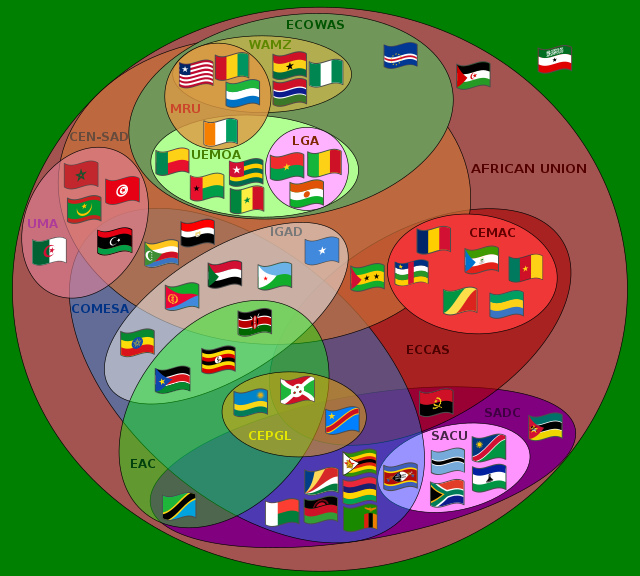
Economy
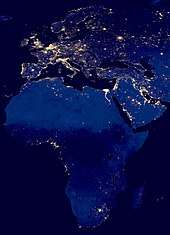
| Rank | Country | GDP (PPP, Peak Year) millions of USD |
Peak Year |
|---|---|---|---|
| 1 | 1,427,432 | 2020 | |
| 2 | 1,215,389 | 2019 | |
| 3 | 804,688 | 2019 | |
| 4 | 668,827 | 2019 | |
| 5 | 327,251 | 2019 | |
| 6 | 253,102 | 2020 | |
| 7 | 220,503 | 2007 | |
| 8 | 209,179 | 2020 | |
| 9 | 200,830 | 2019 | |
| 10 | 198,652 | 2020 |
| Rank | Country | GDP (nominal, Peak Year) millions of USD |
Peak Year |
|---|---|---|---|
| 1 | 568,496 | 2014 | |
| 2 | 416,879 | 2011 | |
| 3 | 353,003 | 2020 | |
| 4 | 213,810 | 2014 | |
| 5 | 145,712 | 2014 | |
| 6 | 124,539 | 2020 | |
| 7 | 109,128 | 2020 | |
| 8 | 103,607 | 2020 | |
| 9 | 79,759 | 2012 | |
| 10 | 72,037 | 1982 |
Although it has abundant natural resources, Africa remains the world's poorest and least-developed continent, the result of a variety of causes that may include corrupt governments that have often committed serious human rights violations, failed central planning, high levels of illiteracy, lack of access to foreign capital, and frequent tribal and military conflict (ranging from guerrilla warfare to genocide).[128] Its total nominal GDP remains behind that of the United States, China, Japan, Germany, the United Kingdom, India and France. According to the United Nations' Human Development Report in 2003, the bottom 24 ranked nations (151st to 175th) were all African.[129]
Poverty, illiteracy, malnutrition and inadequate water supply and sanitation, as well as poor health, affect a large proportion of the people who reside in the African continent. In August 2008, the World Bank[130] announced revised global poverty estimates based on a new international poverty line of $1.25 per day (versus the previous measure of $1.00). 81% of the Sub-Saharan Africa population was living on less than $2.50 (PPP) per day in 2005, compared with 86% for India.[131]
Sub-Saharan Africa is the least successful region of the world in reducing poverty ($1.25 per day); some 50% of the population living in poverty in 1981 (200 million people), a figure that rose to 58% in 1996 before dropping to 50% in 2005 (380 million people). The average poor person in sub-Saharan Africa is estimated to live on only 70 cents per day, and was poorer in 2003 than in 1973,[132] indicating increasing poverty in some areas. Some of it is attributed to unsuccessful economic liberalization programmes spearheaded by foreign companies and governments, but other studies have cited bad domestic government policies more than external factors.[133][134][135]
Africa is now at risk of being in debt once again, particularly in Sub-Saharan African countries. The last debt crisis in 2005 was resolved with help from the heavily indebted poor countries scheme (HIPC). The HIPC resulted in some positive and negative effects on the economy in Africa. About ten years after the 2005 debt crisis in Sub-Saharan Africa was resolved, Zambia fell back into debt. A small reason was due to the fall in copper prices in 2011, but the bigger reason was that a large amount of the money Zambia borrowed was wasted or pocketed by the elite.[136]
From 1995 to 2005, Africa's rate of economic growth increased, averaging 5% in 2005. Some countries experienced still higher growth rates, notably Angola, Sudan and Equatorial Guinea, all of which had recently begun extracting their petroleum reserves or had expanded their oil extraction capacity.
In a recently published analysis based on World Values Survey data, the Austrian political scientist Arno Tausch maintained that several African countries, most notably Ghana, perform quite well on scales of mass support for democracy and the market economy.[137]
Tausch's global value comparison based on the World Values Survey derived the following factor analytical scales: 1. The non-violent and law-abiding society 2. Democracy movement 3. Climate of personal non-violence 4. Trust in institutions 5. Happiness, good health 6. No redistributive religious fundamentalism 7. Accepting the market 8. Feminism 9. Involvement in politics 10. Optimism and engagement 11. No welfare mentality, acceptancy of the Calvinist work ethics. The spread in the performance of African countries with complete data, Tausch concluded "is really amazing". While one should be especially hopeful about the development of future democracy and the market economy in Ghana, the article suggests pessimistic tendencies for Egypt and Algeria, and especially for Africa's leading economy, South Africa. High Human Inequality, as measured by the UNDP's Human Development Report's Index of Human Inequality, further impairs the development of Human Security. Tausch also maintains that the certain recent optimism, corresponding to economic and human rights data, emerging from Africa, is reflected in the development of a civil society.
The continent is believed to hold 90% of the world's cobalt, 90% of its platinum, 50% of its gold, 98% of its chromium, 70% of its tantalite,[138] 64% of its manganese and one-third of its uranium.[139] The Democratic Republic of the Congo (DRC) has 70% of the world's coltan, a mineral used in the production of tantalum capacitors for electronic devices such as cell phones. The DRC also has more than 30% of the world's diamond reserves.[140] Guinea is the world's largest exporter of bauxite.[141] As the growth in Africa has been driven mainly by services and not manufacturing or agriculture, it has been growth without jobs and without reduction in poverty levels. In fact, the food security crisis of 2008 which took place on the heels of the global financial crisis pushed 100 million people into food insecurity.[142]
In recent years, the People's Republic of China has built increasingly stronger ties with African nations and is Africa's largest trading partner. In 2007, Chinese companies invested a total of US$1 billion in Africa.[92]
A Harvard University study led by professor Calestous Juma showed that Africa could feed itself by making the transition from importer to self-sufficiency. "African agriculture is at the crossroads; we have come to the end of a century of policies that favoured Africa's export of raw materials and importation of food. Africa is starting to focus on agricultural innovation as its new engine for regional trade and prosperity."[143]
During US President Barack Obama's visit to Africa in July 2013, he announced a US$7 billion plan to further develop infrastructure and work more intensively with African heads of state. He also announced a new programme named Trade Africa, designed to boost trade within the continent as well as between Africa and the US.[144]
Demographics
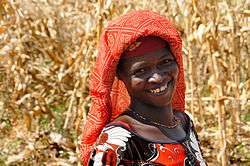
| Population of Africa 1955–2019 | |
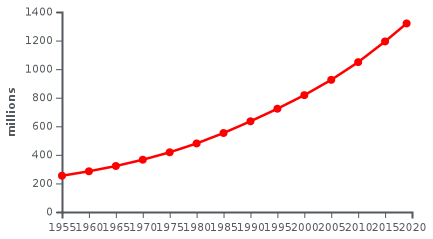 | |
| Source: Worldometers[145] | |
Africa's population has rapidly increased over the last 40 years, and consequently, it is relatively young. In some African states, more than half the population is under 25 years of age.[146] The total number of people in Africa increased from 229 million in 1950 to 630 million in 1990.[147] As of 2018, the population of Africa is estimated at 1.3 billion [1][2]. Africa's total population surpassing other continents is fairly recent; African population surpassed Europe in the 1990s, while the Americas was overtaken sometime around the year 2000; Africa's rapid population growth is expected to overtake the only two nations currently larger than its population, at roughly the same time – India and China's 1.4 billion people each will swap ranking around the year 2022.[148] This increase in number of babies born in Africa compared to the rest of the world is expected to reach approximately 37% in the year 2050, an increase of 21% since 1990 alone.[149]
Speakers of Bantu languages (part of the Niger–Congo family) are the majority in southern, central and southeast Africa. The Bantu-speaking peoples from the Sahel progressively expanded over most of Sub-Saharan Africa.[150] But there are also several Nilotic groups in South Sudan and East Africa, the mixed Swahili people on the Swahili Coast, and a few remaining indigenous Khoisan ("San" or "Bushmen") and Pygmy peoples in southern and central Africa, respectively. Bantu-speaking Africans also predominate in Gabon and Equatorial Guinea, and are found in parts of southern Cameroon. In the Kalahari Desert of Southern Africa, the distinct people known as the Bushmen (also "San", closely related to, but distinct from "Hottentots") have long been present. The San are physically distinct from other Africans and are the indigenous people of southern Africa. Pygmies are the pre-Bantu indigenous peoples of central Africa.[151]
The peoples of West Africa primarily speak Niger–Congo languages, belonging mostly to its non-Bantu branches, though some Nilo-Saharan and Afro-Asiatic speaking groups are also found. The Niger–Congo-speaking Yoruba, Igbo, Fulani, Akan and Wolof ethnic groups are the largest and most influential. In the central Sahara, Mandinka or Mande groups are most significant. Chadic-speaking groups, including the Hausa, are found in more northerly parts of the region nearest to the Sahara, and Nilo-Saharan communities, such as the Songhai, Kanuri and Zarma, are found in the eastern parts of West Africa bordering Central Africa.
The peoples of North Africa consist of three main indigenous groups: Berbers in the northwest, Egyptians in the northeast, and Nilo-Saharan-speaking peoples in the east. The Arabs who arrived in the 7th century AD introduced the Arabic language and Islam to North Africa. The Semitic Phoenicians (who founded Carthage) and Hyksos, the Indo-Iranian Alans, the Indo- European Greeks, Romans, and Vandals settled in North Africa as well. Significant Berber communities remain within Morocco and Algeria in the 21st century, while, to a lesser extent, Berber speakers are also present in some regions of Tunisia and Libya.[152] The Berber-speaking Tuareg and other often-nomadic peoples are the principal inhabitants of the Saharan interior of North Africa. In Mauritania, there is a small but near-extinct Berber community in the north and Niger–Congo-speaking peoples in the south, though in both regions Arabic and Arab culture predominates. In Sudan, although Arabic and Arab culture predominate, it is mostly inhabited by groups that originally spoke Nilo-Saharan, such as the Nubians, Fur, Masalit and Zaghawa, who, over the centuries, have variously intermixed with migrants from the Arabian peninsula. Small communities of Afro-Asiatic-speaking Beja nomads can also be found in Egypt and Sudan.[153]
In the Horn of Africa, some Ethiopian and Eritrean groups (like the Amhara and Tigrayans, collectively known as Habesha) speak languages from the Semitic branch of the Afro-Asiatic language family, while the Oromo and Somali speak languages from the Cushitic branch of Afro-Asiatic.
Prior to the decolonization movements of the post-World War II era, Europeans were represented in every part of Africa.[154] Decolonization during the 1960s and 1970s often resulted in the mass emigration of white settlers – especially from Algeria and Morocco (1.6 million pieds-noirs in North Africa),[155] Kenya, Congo,[156] Rhodesia, Mozambique and Angola.[157] Between 1975 and 1977, over a million colonials returned to Portugal alone.[158] Nevertheless, white Africans remain an important minority in many African states, particularly Zimbabwe, Namibia, Réunion, and the Republic of South Africa.[159] The country with the largest white African population is South Africa.[160] Dutch and British diasporas represent the largest communities of European ancestry on the continent today.[161]
European colonization also brought sizable groups of Asians, particularly from the Indian subcontinent, to British colonies. Large Indian communities are found in South Africa, and smaller ones are present in Kenya, Tanzania, and some other southern and southeast African countries. The large Indian community in Uganda was expelled by the dictator Idi Amin in 1972, though many have since returned. The islands in the Indian Ocean are also populated primarily by people of Asian origin, often mixed with Africans and Europeans. The Malagasy people of Madagascar are an Austronesian people, but those along the coast are generally mixed with Bantu, Arab, Indian and European origins. Malay and Indian ancestries are also important components in the group of people known in South Africa as Cape Coloureds (people with origins in two or more races and continents). During the 20th century, small but economically important communities of Lebanese and Chinese[92] have also developed in the larger coastal cities of West and East Africa, respectively.[162]
Languages

By most estimates, well over a thousand languages (UNESCO has estimated around two thousand) are spoken in Africa.[163] Most are of African origin, though some are of European or Asian origin. Africa is the most multilingual continent in the world, and it is not rare for individuals to fluently speak not only multiple African languages, but one or more European ones as well. There are four major language families indigenous to Africa:
- The Afroasiatic languages are a language family of about 240 languages and 285 million people widespread throughout the Horn of Africa, North Africa, the Sahel, and Southwest Asia.
- The Nilo-Saharan language family consists of more than a hundred languages spoken by 30 million people. Nilo-Saharan languages are spoken by ethnic groups in Chad, Ethiopia, Kenya, Nigeria, Sudan, South Sudan, Uganda, and northern Tanzania.
- The Niger-Congo language family covers much of Sub-Saharan Africa. In terms of number of languages, it is the largest language family in Africa and perhaps one of the largest in the world.
- The Khoisan languages number about fifty and are spoken in Southern Africa by approximately 400,000 people.[164] Many of the Khoisan languages are endangered. The Khoi and San peoples are considered the original inhabitants of this part of Africa.
Following the end of colonialism, nearly all African countries adopted official languages that originated outside the continent, although several countries also granted legal recognition to indigenous languages (such as Swahili, Yoruba, Igbo and Hausa). In numerous countries, English and French (see African French) are used for communication in the public sphere such as government, commerce, education and the media. Arabic, Portuguese, Afrikaans and Spanish are examples of languages that trace their origin to outside of Africa, and that are used by millions of Africans today, both in the public and private spheres. Italian is spoken by some in former Italian colonies in Africa. German is spoken in Namibia, as it was a former German protectorate.
Culture
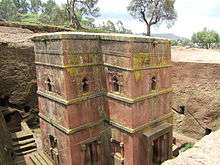
Some aspects of traditional African cultures have become less practised in recent years as a result of neglect and suppression by colonial and post-colonial regimes. For example, African customs were discouraged, and African languages were prohibited in mission schools.[165] Leopold II of Belgium attempted to "civilize" Africans by discouraging polygamy and witchcraft.[165]
Obidoh Freeborn posits that colonialism is one element that has created the character of modern African art.[166] According to authors Douglas Fraser and Herbert M. Cole, "The precipitous alterations in the power structure wrought by colonialism were quickly followed by drastic iconographic changes in the art." [167] Fraser and Cole assert that, in Igboland, some art objects "lack the vigor and careful craftsmanship of the earlier art objects that served traditional functions.[167] Author Chika Okeke-Agulu states that "the racist infrastructure of British imperial enterprise forced upon the political and cultural guardians of empire a denial and suppression of an emergent sovereign Africa and modernist art." [168] Editors F. Abiola Irele and Simon Gikandi comment that the current identity of African literature had its genesis in the "traumatic encounter between Africa and Europe."[169] On the other hand, Mhoze Chikowero believes that Africans deployed music, dance, spirituality, and other performative cultures to (re)asset themselves as active agents and indigenous intellectuals, to unmake their colonial marginalization and reshape their own destinies." [170]
There is now a resurgence in the attempts to rediscover and revalue African traditional cultures, under such movements as the African Renaissance, led by Thabo Mbeki, Afrocentrism, led by a group of scholars, including Molefi Asante, as well as the increasing recognition of traditional spiritualism through decriminalization of Vodou and other forms of spirituality.
Visual art and architecture
African art and architecture reflect the diversity of African cultures. The region's oldest known beads were made from Nassarius shells and worn as personal ornaments 72,000 years ago.[171] The Great Pyramid of Giza in Egypt was the world's tallest structure for 4,000 years, until the completion of Lincoln Cathedral around the year 1300. The stone ruins of Great Zimbabwe are also noteworthy for their architecture, as are the monolithic churches at Lalibela, Ethiopia, such as the Church of Saint George.
Music and dance
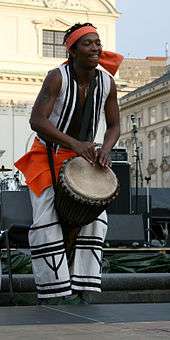
Egypt has long been a cultural focus of the Arab world, while remembrance of the rhythms of sub-Saharan Africa, in particular West Africa, was transmitted through the Atlantic slave trade to modern samba, blues, jazz, reggae, hip hop, and rock. The 1950s through the 1970s saw a conglomeration of these various styles with the popularization of Afrobeat and Highlife music. Modern music of the continent includes the highly complex choral singing of southern Africa and the dance rhythms of the musical genre of soukous, dominated by the music of the Democratic Republic of Congo. Indigenous musical and dance traditions of Africa are maintained by oral traditions, and they are distinct from the music and dance styles of North Africa and Southern Africa. Arab influences are visible in North African music and dance and, in Southern Africa, Western influences are apparent due to colonization.
Sports
Fifty-four African countries have football (soccer) teams in the Confederation of African Football. Egypt has won the African Cup seven times, and a record-making three times in a row. Cameroon, Nigeria, Senegal, Ghana, and Algeria have advanced to the knockout stage of recent FIFA World Cups. South Africa hosted the 2010 World Cup tournament, becoming the first African country to do so.
Cricket is popular in some African nations. South Africa and Zimbabwe have Test status, while Kenya is the leading non-test team and previously had One-Day International cricket (ODI) status (from 10 October 1997, until 30 January 2014). The three countries jointly hosted the 2003 Cricket World Cup. Namibia is the other African country to have played in a World Cup. Morocco in northern Africa has also hosted the 2002 Morocco Cup, but the national team has never qualified for a major tournament. Rugby is a popular sport in South Africa, Namibia, and Zimbabwe.
Religion
Africans profess a wide variety of religious beliefs, and statistics on religious affiliation are difficult to come by since they are often a sensitive topic for governments with mixed religious populations.[172][173] According to the World Book Encyclopedia, Islam and Christianity are the two largest religions in Africa. According to Encyclopædia Britannica, 45% of the population are Christians, 40% are Muslims, and 10% follow traditional religions. A small number of Africans are Hindu, Buddhist, Confucianist, Baha'i, or Jewish. There is also a minority of people in Africa who are irreligious.
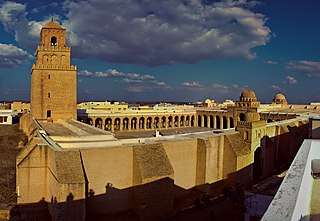
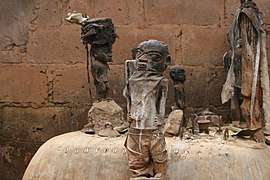
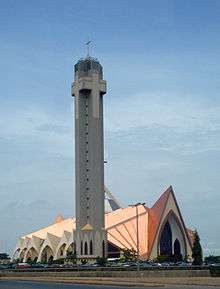 National Church of Nigeria, Abuja
National Church of Nigeria, Abuja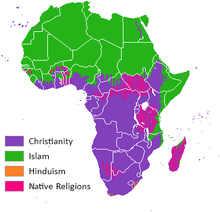 A map showing religious distribution in Africa
A map showing religious distribution in Africa
Territories and regions
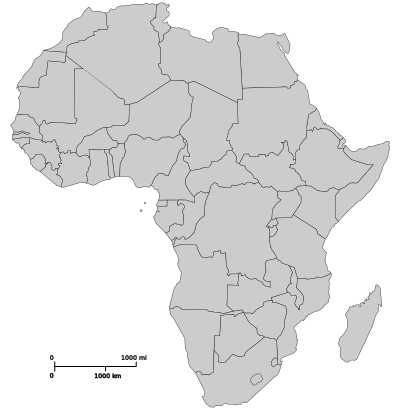
The countries in this table are categorized according to the scheme for geographic subregions used by the United Nations, and data included are per sources in cross-referenced articles. Where they differ, provisos are clearly indicated.
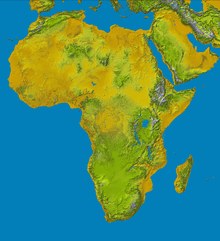 Physical map of Africa |
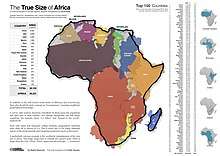 The size of Africa compared with distinctive territories from other parts of the world.[175] Especially since the beginning of the 1900s, the Western maps have downplayed the real size of the continent through map projection.[176] |
| Arms | Flag | Name of region[177] and territory, with flag |
Area (km²) |
Population[178] | Year | Density (per km²) |
Capital |
|---|---|---|---|---|---|---|---|
| North Africa | |||||||
| Algeria | 2,381,740 | 34,178,188 | 2009 | 14 | Algiers | ||
| Canary Islands (Spain)[179] | 7,492 | 2,154,905 | 2017 | 226 | Las Palmas de Gran Canaria, Santa Cruz de Tenerife | ||
| Ceuta (Spain)[180] | 20 | 85,107 | 2017 | 3,575 | — | ||
| Egypt[181] | 1,001,450 | 82,868,000 | 2012 | 83 | Cairo | ||
| Libya | 1,759,540 | 6,310,434 | 2009 | 4 | Tripoli | ||
| Madeira (Portugal)[182] | 797 | 245,000 | 2001 | 307 | Funchal | ||
| Melilla (Spain)[183] | 12 | 85,116 | 2017 | 5,534 | — | ||
| Morocco | 446,550 | 35,740,000 | 2017 | 78 | Rabat | ||
| Tunisia | 163,610 | 10,486,339 | 2009 | 64 | Tunis | ||
| Western Sahara[184] | 266,000 | 405,210 | 2009 | 2 | El Aaiún | ||
| East Africa | |||||||
| Burundi | 27,830 | 8,988,091 | 2009 | 323 | Gitega | ||
| Comoros | 2,170 | 752,438 | 2009 | 347 | Moroni | ||
| Djibouti | 23,000 | 828,324 | 2015 | 22 | Djibouti | ||
| Eritrea | 121,320 | 5,647,168 | 2009 | 47 | Asmara | ||
| Ethiopia | 1,127,127 | 84,320,987 | 2012 | 75 | Addis Ababa | ||
| French Southern Territories (France) | 439,781 | 100 | 2019 | — | Saint Pierre | ||
| Kenya | 582,650 | 39,002,772 | 2009 | 66 | Nairobi | ||
| Madagascar | 587,040 | 20,653,556 | 2009 | 35 | Antananarivo | ||
| Malawi | 118,480 | 14,268,711 | 2009 | 120 | Lilongwe | ||
| Mauritius | 2,040 | 1,284,264 | 2009 | 630 | Port Louis | ||
| Mayotte (France) | 374 | 223,765 | 2009 | 490 | Mamoudzou | ||
| Mozambique | 801,590 | 21,669,278 | 2009 | 27 | Maputo | ||
| Réunion (France) | 2,512 | 743,981 | 2002 | 296 | Saint Denis | ||
| Rwanda | 26,338 | 10,473,282 | 2009 | 398 | Kigali | ||
| Seychelles | 455 | 87,476 | 2009 | 192 | Victoria | ||
| Somalia | 637,657 | 9,832,017 | 2009 | 15 | Mogadishu | ||
| South Sudan | 619,745 | 8,260,490 | 2008 | 13 | Juba | ||
| Sudan | 1,861,484 | 30,894,000 | 2008 | 17 | Khartoum | ||
| Tanzania | 945,087 | 44,929,002 | 2009 | 43 | Dodoma | ||
| Uganda | 236,040 | 32,369,558 | 2009 | 137 | Kampala | ||
| Central Africa | |||||||
| Angola | 1,246,700 | 12,799,293 | 2009 | 10 | Luanda | ||
| Cameroon | 475,440 | 18,879,301 | 2009 | 40 | Yaoundé | ||
| Central African Republic | 622,984 | 4,511,488 | 2009 | 7 | Bangui | ||
| Chad | 1,284,000 | 10,329,208 | 2009 | 8 | N'Djamena | ||
| Republic of the Congo | 342,000 | 4,012,809 | 2009 | 12 | Brazzaville | ||
| Democratic Republic of the Congo | 2,345,410 | 69,575,000 | 2012 | 30 | Kinshasa | ||
| Equatorial Guinea | 28,051 | 633,441 | 2009 | 23 | Malabo | ||
| Gabon | 267,667 | 1,514,993 | 2009 | 6 | Libreville | ||
| São Tomé and Príncipe | 1,001 | 212,679 | 2009 | 212 | São Tomé | ||
| Southern Africa | |||||||
| Botswana | 600,370 | 1,990,876 | 2009 | 3 | Gaborone | ||
| Eswatini | 17,363 | 1,123,913 | 2009 | 65 | Mbabane | ||
| Lesotho | 30,355 | 2,130,819 | 2009 | 70 | Maseru | ||
| Namibia | 825,418 | 2,108,665 | 2009 | 3 | Windhoek | ||
| Zambia | 752,614 | 11,862,740 | 2009 | 16 | Lusaka | ||
| Zimbabwe | 390,580 | 11,392,629 | 2009 | 29 | Harare | ||
| South Africa | 1,219,912 | 51,770,560 | 2011 | 42 | Bloemfontein, Cape Town, Pretoria[185] | ||
| West Africa | |||||||
| Benin | 112,620 | 8,791,832 | 2009 | 78 | Porto-Novo | ||
| Burkina Faso | 274,200 | 15,746,232 | 2009 | 57 | Ouagadougou | ||
| Cape Verde | 4,033 | 429,474 | 2009 | 107 | Praia | ||
| The Gambia | 11,300 | 1,782,893 | 2009 | 158 | Banjul | ||
| Ghana | 239,460 | 23,832,495 | 2009 | 100 | Accra | ||
| Guinea | 245,857 | 10,057,975 | 2009 | 41 | Conakry | ||
| Guinea-Bissau | 36,120 | 1,533,964 | 2009 | 43 | Bissau | ||
| Ivory Coast | 322,460 | 20,617,068 | 2009 | 64 | Abidjan,[186] Yamoussoukro | ||
| Liberia | 111,370 | 3,441,790 | 2009 | 31 | Monrovia | ||
| Mali | 1,240,000 | 12,666,987 | 2009 | 10 | Bamako | ||
| Mauritania | 1,030,700 | 3,129,486 | 2009 | 3 | Nouakchott | ||
| Niger | 1,267,000 | 15,306,252 | 2009 | 12 | Niamey | ||
| Nigeria | 923,768 | 166,629,000 | 2012 | 180 | Abuja | ||
| Saint Helena, Ascension and Tristan da Cunha (United Kingdom) | 420 | 7,728 | 2012 | 13 | Jamestown | ||
| Senegal | 196,190 | 13,711,597 | 2009 | 70 | Dakar | ||
| Sierra Leone | 71,740 | 6,440,053 | 2009 | 90 | Freetown | ||
| Togo | 56,785 | 6,019,877 | 2009 | 106 | Lomé | ||
| Africa Total | 30,368,609 | 1,001,320,281 | 2009 | 33 | |||
See also
References
- ""World Population prospects – Population division"". population.un.org. United Nations Department of Economic and Social Affairs, Population Division. Retrieved 9 November 2019.
- ""Overall total population" – World Population Prospects: The 2019 Revision" (xslx). population.un.org (custom data acquired via website). United Nations Department of Economic and Social Affairs, Population Division. Retrieved 9 November 2019.
- "IMF (WEO April 2019 Edition) GDP nominal and PPP data – international dollar".
- Sayre, April Pulley (1999), Africa, Twenty-First Century Books. ISBN 0-7613-1367-2.
- Swanson, Ana (17 August 2015). "5 ways the world will look dramatically different in 2100". Washington Post.
- Harry, Njideka U. (11 September 2013). "African Youth, Innovation and the Changing Society". Huffington Post.
- Janneh, Abdoulie (April 2012). "item,4 of the provisional agenda – General debate on national experience in population matters: adolescents and youth" (PDF). United Nations Economic Commission for Africa. Retrieved 15 December 2015.
- "Africa. General info". Visual Geography. Archived from the original on 24 April 2011. Retrieved 24 November 2007.
- Schneider, S.H.; et al. (2007). "19.3.3 Regional vulnerabilities". In Parry, M.L.; et al. (eds.). Chapter 19: Assessing Key Vulnerabilities and the Risk from Climate Change. Climate change 2007: impacts, adaptation, and vulnerability: contribution of Working Group II to the fourth assessment report of the Intergovernmental Panel on Climate Change (IPCC). Cambridge University Press (CUP): Cambridge, UK: Print version: CUP. This version: IPCC website. ISBN 978-0-521-88010-7. Archived from the original on 12 March 2013. Retrieved 15 September 2011.
- Niang, I., O.C. Ruppel, M.A. Abdrabo, A. Essel, C. Lennard, J. Padgham, and P. Urquhart, 2014: Africa. In: Climate Change 2014: Impacts, Adaptation, and Vulnerability. Part B: Regional Aspects. Contribution of Working Group II to the Fifth Assessment Report of the Intergovernmental Panel on Climate Change [Barros, V.R., C.B. Field, D.J. Dokken et al. (eds.)]. Cambridge University Press, Cambridge, United Kingdom and New York, NY, USA, pp. 1199-1265. https://www.ipcc.ch/site/assets/uploads/2018/02/WGIIAR5-Chap22_FINAL.pdf
- "Homo sapiens: University of Utah News Release: 16 February 2005". Archived from the original on 24 October 2007.
- Schlebusch, Carina M; Malmström, Helena; Günther, Torsten; Sjödin, Per; Coutinho, Alexandra; Edlund, Hanna; Munters, Arielle R; Vicente, Mário; Steyn, Maryna; Soodyall, Himla; Lombard, Marlize; Jakobsson, Mattias (2017). "Southern African ancient genomes estimate modern human divergence to 350,000 to 260,000 years ago". Science. 358 (6363): 652–655. Bibcode:2017Sci...358..652S. doi:10.1126/science.aao6266. PMID 28971970.
- Sample, Ian (7 June 2017). "Oldest Homo sapiens bones ever found shake foundations of the human story". The Guardian. Retrieved 7 June 2017.
- Zimmer, Carl (10 September 2019). "Scientists Find the Skull of Humanity's Ancestor — on a Computer - By comparing fossils and CT scans, researchers say they have reconstructed the skull of the last common forebear of modern humans". The New York Times. Retrieved 10 September 2019.
- Mounier, Aurélien; Lahr, Marta (2019). "Deciphering African late middle Pleistocene hominin diversity and the origin of our species". Nature Communications. 10 (1): 3406. Bibcode:2019NatCo..10.3406M. doi:10.1038/s41467-019-11213-w. PMC 6736881. PMID 31506422.
- Georges, Karl Ernst (1913–1918). "Afri". In Georges, Heinrich (ed.). Ausführliches lateinisch-deutsches Handwörterbuch (in German) (8th ed.). Hannover. Archived from the original on 16 January 2016. Retrieved 20 September 2015.
- Lewis, Charlton T.; Short, Charles (1879). "Afer". A Latin Dictionary. Oxford: Clarendon Press. Retrieved 20 September 2015.
- Venter & Neuland, NEPAD and the African Renaissance (2005), p. 16
- Desfayes, Michel (25 January 2011). "The Names of Countries". michel-desfayes.org. Archived from the original on 27 June 2019. Retrieved 9 April 2019.
Africa. From the name of an ancient tribe in Tunisia, the Afri (adjective: Afer). The name is still extant today as Ifira and Ifri-n-Dellal in Greater Kabylia (Algeria). A Berber tribe was called Beni-Ifren in the Middle Ages and Ifurace was the name of a Tripolitan people in the 6th century. The name is from the Berber language ifri 'cave'. Troglodytism was frequent in northern Africa and still occurs today in southern Tunisia. Herodote wrote that the Garamantes, a North African people, used to live in caves. The Ancient Greek called troglodytēs an African people who lived in caves. Africa was coined by the Romans and 'Ifriqiyeh' is the arabized Latin name. (Most details from Decret & Fantar, 1981).
- Babington Michell, Geo (1903). "The Berbers". Journal of the Royal African Society. 2 (6): 161–194. doi:10.1093/oxfordjournals.afraf.a093193. JSTOR 714549.
- Edward Lipinski, Itineraria Phoenicia, Peeters Publishers, 2004, p. 200. ISBN 90-429-1344-4
- "Africa African Africanus Africus". Consultos.com.
- "Nile Genesis: the opus of Gerald Massey". Gerald-massey.org.uk. 29 October 1907. Archived from the original on 30 January 2010. Retrieved 18 May 2010.
- Fruyt, M. (1976). "D'Africus ventus a Africa terrain". Revue de Philologie. 50: 221–38.
- Stieglitz, Robert R. (1984). "Long-Distance Seafaring in the Ancient Near East". The Biblical Archaeologist. 47 (3): 134–142. doi:10.2307/3209914. JSTOR 3209914.
- Hallikan, 'Abu-l-'Abbas Sams-al-din 'Ahmad ibn Muhammad Ibn (1842). Kitab Wafayat Ala'yan. Ibn Khallikan's Biographical Dictionary Transl. by (Guillaume) B(aro)n Mac-Guckin de Slane. Benjamin Duprat.
- al-Andalusi, Sa'id (2010). Science in the Medieval World. University of Texas Press. ISBN 9780292792319.
- Upton, Roger D. (1881). Travels in the Arabian Desert: With Special Reference to the Arabian Horse and Its Pedigree. C.K. Paul & Company.
- Genetic study roots humans in Africa, BBC News, SCI/TECH
- Migration of Early Humans From Africa Aided By Wet Weather, sciencedaily.com
- Kimbel, William H. and Yoel Rak and Donald C. Johanson. (2004) The Skull of Australopithecus Afarensis, Oxford University Press US. ISBN 0-19-515706-0
- Tudge, Colin. (2002) The Variety of Life., Oxford University Press. ISBN 0-19-860426-2
- van Sertima, Ivan. (1995) Egypt: Child of Africa/S V12 (Ppr), Transaction Publishers. pp. 324–25. ISBN 1-56000-792-3
- Mokhtar, G. (1990) UNESCO General History of Africa, Vol. II, Abridged Edition: Ancient Africa, University of California Press. ISBN 0-85255-092-8
- Eyma, A.K. and C.J. Bennett. (2003) Delts-Man in Yebu: Occasional Volume of the Egyptologists' Electronic Forum No. 1, Universal Publishers. p. 210. ISBN 1-58112-564-X
- Wells, Spencer (December 2002) The Journey of Man. National Geographic
- Oppenheimer, Stephen. The Gates of Grief Archived 30 May 2014 at the Wayback Machine. bradshawfoundation.com
- "15. Strait of Gibraltar, Atlantic Ocean/Mediterranean Sea". www.lpi.usra.edu. Retrieved 13 May 2020.
- Fregel, Rosa; Méndez, Fernando L.; Bokbot, Youssef; Martín-Socas, Dimas; Camalich-Massieu, María D.; Santana, Jonathan; Morales, Jacob; Ávila-Arcos, María C.; Underhill, Peter A.; Shapiro, Beth; Wojcik, Genevieve (26 June 2018). "Ancient genomes from North Africa evidence prehistoric migrations to the Maghreb from both the Levant and Europe". Proceedings of the National Academy of Sciences. 115 (26): 6774–6779. doi:10.1073/pnas.1800851115. ISSN 0027-8424. PMID 29895688.
- Derricourt, Robin (2005). "Getting "Out of Africa": Sea Crossings, Land Crossings and Culture in the Hominin Migrations" (PDF). Journal of World Prehistory. 19 (2): 119–132. doi:10.1007/s10963-006-9002-z.
- Goucher, Candice; Walton, Linda (2013). World History: Journeys from Past to Present. Routledge. pp. 2–20. ISBN 978-1-134-72354-6.
- Keenan, Jeremy (2013). The Sahara: Past, Present and Future. Routledge. ISBN 978-1-317-97001-9.
- Mercier, Norbert; et al. (2012). "OSL dating of quaternary deposits associated with the parietal art of the Tassili-n-Ajjer plateau (Central Sahara)". Quaternary Geochronology. 10: 367–73. doi:10.1016/j.quageo.2011.11.010.
- "Sahara's Abrupt Desertification Started by Changes in Earth's Orbit, Accelerated by Atmospheric and Vegetation Feedbacks" Archived 7 March 2014 at the Wayback Machine, Science Daily
- Diamond, Jared. (1999) Guns, Germs and Steel: The Fates of Human Societies. New York: Norton, p. 167. ISBN 978-0813498027
- O'Brien, Patrick K. ed. (2005) Oxford Atlas of World History. New York: Oxford University Press. pp. 22–23. ISBN 9780199746538
- Martin and O'Meara, "Africa, 3rd Ed." Archived 11 October 2007 at the Wayback Machine Indiana: Indiana University Press, 1995
- Were Egyptians the first scribes? BBC News (15 December 1998)
- Hassan, Fekri A. (2002) Droughts, Food and Culture, Springer. p. 17. ISBN 0-306-46755-0
- McGrail, Sean. (2004) Boats of the World, Oxford University Press. p. 48. ISBN 0-19-927186-0
- Shavit, Jacob; Shavit, Yaacov (2001). History in Black: African-Americans in Search of an Ancient Past. Taylor & Francis. p. 77. ISBN 978-0-7146-8216-7.
- Fage, J.D. (1979), The Cambridge History of Africa, Cambridge University Press. ISBN 0-521-21592-7
- Fage, J.D., et al. (1986), The Cambridge History of Africa, Cambridge University Press. Vol. 2, p. 118. doi:10.1017/CHOL9780521215923.004. ISBN 9781139054560
- Oliver, Roland and Anthony Atmore (1994), Africa Since 1800, Cambridge University Press. ISBN 0-521-42970-6
- "The Berlin Conference | Western Civilization II (HIS 104) – Biel". courses.lumenlearning.com. Retrieved 13 May 2020.
- "Greeks, Romans and Barbarians".
- "Ptolemaic and Roman Egypt: 332 BC – 395 AD". Wsu.edu. 6 June 1999. Archived from the original on 28 May 2010. Retrieved 18 May 2010.
- "New exhibition about Roman Emperor Septimius Severus at the Yorkshire Museum". The Press. 2 February 2011. Retrieved 15 December 2013.
- "The Story of Africa – Christianity". BBC World Service. BBC. Retrieved 15 December 2013.
- Tesfagiorgis, Mussie (2010). Eritrea. ABC-CLIO. p. 153. ISBN 978-1-59884-232-6.
- Ayoub, Mahmoud M. (2004). Islam: Faith and History. Oxford: Oneworld. pp. 76, 92–93, 96–97.
- Holl, Augustin (1985). "Background to the Ghana Empire: archaeological investigations on the transition to statehood in the Dhar Tichitt region (Mauritania)". Journal of Anthropological Archaeology. 4 (2): 73–115. doi:10.1016/0278-4165(85)90005-4.
- Iliffe, John (2007). pp. 49–50
- Collins and Burns (2007), p. 78.
- Shillington, Kevin (2005), p. 39.
- Honour, Hugh; Fleming, John (2005). A world history of art (7th ed.). London: Laurence King. ISBN 9781856694513.
- Meredith, Martin (20 January 2006). "The Fate of Africa – A Survey of Fifty Years of Independence". Washington Post. Retrieved 23 July 2007.
- "Igbo-Ukwu (c. 9th century) | Thematic Essay | Heilbrunn Timeline of Art History | The Metropolitan Museum of Art". Metmuseum.org. Retrieved 18 May 2010.
- Glick, Thomas F. (2005) Islamic And Christian Spain in the Early Middle Ages. Brill Academic Publishers, p. 37. ISBN 9789004147713
- "Mauritania – Arab Invasions". countrystudies.us.
- Nebel, A; et al. (1 April 2010). "Genetic Evidence for the Expansion of Arabian Tribes into the Southern Levant and North Africa". American Journal of Human Genetics. 70 (6): 1594–96. doi:10.1086/340669. PMC 379148. PMID 11992266.
- Lapidus, Ira M. (1988) A History of Islamic Societies, Cambridge.
- Historical survey: Slave societies, Encyclopædia Britannica
- Swahili Coast Archived 6 December 2007 at the Wayback Machine, National Geographic
- Welcome to Encyclopædia Britannica's Guide to Black History, Encyclopædia Britannica
- "Focus on the slave trade". bbc.co.uk. BBC News – Africa. 3 September 2001.
- Lovejoy, Paul E. (2000). Transformations in Slavery: A History of Slavery in Africa. Cambridge University Press. p. 25. ISBN 978-0-521-78430-6.
- Rees Davies, "British Slaves on the Barbary Coast", BBC, 1 July 2003
- Jo Loosemore, Sailing against slavery. BBC
- "The West African Squadron and slave trade". Pdavis.nl. Archived from the original on 10 June 2010. Retrieved 18 May 2010.
- Simon, Julian L. (1995) State of Humanity, Blackwell Publishing. p. 175. ISBN 1-55786-585-X
- Brantlinger, Patrick (1985). "Victorians and Africans: The Genealogy of the Myth of the Dark Continent". Critical Inquiry. 12 (1): 166–203. doi:10.1086/448326. JSTOR 1343467.
- R. Robinson, J. Gallagher and A. Denny, Africa and the Victorians, London, 1965, p. 175.
- Kevin Shillington, History of Africa. Revised second edition (New York: Macmillan Publishers Limited, 2005), 301.
- Bély, Lucien (2001). The History of France. Editions Jean-paul Gisserot. p. 118. ISBN 978-2-87747-563-1.
- Aryeetey, Ernest; Harrigan, Jane; Nissanke Machiko (2000). Economic Reforms in Ghana: The Miracle and the Mirage. Africa World Press. p. 5. ISBN 978-0-86543-844-6.
- International Monetary Fund. International Monetary Fund. IMF. OCLC 40951957.
- "BBC: 1984 famine in Ethiopia". BBC News. 6 April 2000. Retrieved 1 January 2010.
- Robert G. Patman, The Soviet Union in the Horn of Africa 1990, ISBN 0-521-36022-6, pp. 295–96
- Steven Varnis, Reluctant aid or aiding the reluctant?: U.S. food aid policy and the Ethiopian Famine Relief 1990, ISBN 0-88738-348-3, p. 38
- Rayner, Gordon (27 September 2011). "Is your mobile phone helping fund war in Congo?". The Daily Telegraph. London.
- Malia Politzer, "China and Africa: Stronger Economic Ties Mean More Migration", Migration Information Source. August 2008
- Jenny Aker, Isaac Mbiti, "Mobile Phones and Economic Development in Africa" SSRN
- "At Least a Million Sub-Saharan Africans Moved to Europe Since 2010". Pew Research Center. 22 March 2018. Archived from the original on 1 March 2019. Retrieved 8 June 2018.
- Drysdale, Alasdair and Gerald H. Blake. (1985) The Middle East and North Africa, Oxford University Press US. ISBN 0-19-503538-0
- "Atlas – Xpeditions". National Geographic Society. 2003. Archived from the original on 3 March 2009. Retrieved 1 March 2009.
- (1998) Merriam-Webster's Geographical Dictionary (Index), Merriam-Webster, pp. 10–11. ISBN 0-87779-546-0
- Lewin, Evans. (1924) Africa, Clarendon press
- Hoare, Ben. (2002) The Kingfisher A–Z Encyclopedia, Kingfisher Publications. p. 11. ISBN 0-7534-5569-2
- "Sizes of Tectonic or Lithospheric Plates". About.com. Retrieved 30 June 2015.
- "Somali Plate". Ashten Sawitsky. Retrieved 30 June 2015.
- Chu, D.; Gordon, R.G. (1999). "Evidence for motion between Nubia and Somalia along the Southwest Indian ridge". Nature. 398 (6722): 64–67. Bibcode:1999Natur.398...64C. doi:10.1038/18014.
- Wood, Eric F.; Berg, Alexis; Vergopolan, Noemi; McVicar, Tim R.; Zimmermann, Niklaus E.; Beck, Hylke E. (30 October 2018). "Present and future Köppen-Geiger climate classification maps at 1-km resolution". Scientific Data. 5: 180214. Bibcode:2018NatSD...580214B. doi:10.1038/sdata.2018.214. PMC 6207062. PMID 30375988.
- "Africa: Environmental Atlas, 06/17/08." Archived 5 January 2012 at the Wayback Machine African Studies Center, University of Pennsylvania. Accessed June 2011.
- El Fadli, KI; et al. (September 2012). "World Meteorological Organization Assessment of the Purported World Record 58°C Temperature Extreme at El Azizia, Libya (13 September 1922)". Bulletin of the American Meteorological Society. 94 (2): 199. Bibcode:2013BAMS...94..199E. doi:10.1175/BAMS-D-12-00093.1. (The 136 °F (57.8 °C), claimed by 'Aziziya, Libya, on 13 September 1922, has been officially deemed invalid by the World Meteorological Organization.)
- "World Meteorological Organization World Weather / Climate Extremes Archive". Archived from the original on 4 January 2013. Retrieved 10 January 2013.
- Deforestation reaches worrying level – UN Archived 6 December 2008 at the Wayback Machine. AfricaNews. 11 June 2008
- Forests and deforestation in Africa – the wasting of an immense resource Archived 20 May 2009 at the Wayback Machine. afrol News
- World Wildlife Fund, ed. (2001). "Madagascar subhumid forests". WildWorld Ecoregion Profile. National Geographic Society. Archived from the original on 8 March 2010.
- "Nature laid waste: The destruction of Africa", The Independent, 11 June 2008.
- Duncan, B. N; West, J. J; Yoshida, Y; Fiore, A. M; Ziemke, J. R (2008). "The influence of European pollution on ozone in the Near East and northern Africa". Atmospheric Chemistry and Physics. 8 (8): 2267–83. doi:10.5194/acp-8-2267-2008.
- Schneider, S.H.; et al. (2007). "19.3.3 Regional vulnerabilities". In Parry, M.L.; et al. (eds.). Chapter 19: Assessing Key Vulnerabilities and the Risk from Climate Change. Climate change 2007: impacts, adaptation, and vulnerability: contribution of Working Group II to the fourth assessment report of the Intergovernmental Panel on Climate Change (IPCC). Cambridge University Press (CUP): Cambridge, UK: Print version: CUP. This version: IPCC website. ISBN 978-0-521-88010-7. Archived from the original on 12 March 2013. Retrieved 15 September 2011.
- Niang, I., O.C. Ruppel, M.A. Abdrabo, A. Essel, C. Lennard, J. Padgham, and P. Urquhart, 2014: Africa. In: Climate Change 2014: Impacts, Adaptation, and Vulnerability. Part B: Regional Aspects. Contribution of Working Group II to the Fifth Assessment Report of the Intergovernmental Panel on Climate Change [Barros, V.R., C.B. Field, D.J. Dokken et al. (eds.)]. Cambridge University Press, Cambridge, United Kingdom and New York, NY, USA, pp. 1199-1265. https://www.ipcc.ch/site/assets/uploads/2018/02/WGIIAR5-Chap22_FINAL.pdf
- Ofoegbu, Chidiebere; Chirwa, P. W. (19 May 2019). "Analysis of rural people's attitude towards the management of tribal forests in South Africa". Journal of Sustainable Forestry. 38 (4): 396–411. doi:10.1080/10549811.2018.1554495. ISSN 1054-9811.
- Niang, I., O.C. Ruppel, M.A. Abdrabo, A. Essel, C. Lennard, J. Padgham, and P. Urquhart, 2014: Africa. In: Climate Change 2014: Impacts, Adaptation, and Vulnerability. Part B: Regional Aspects. Contribution of Working Group II to the Fifth Assessment Report of the Intergovernmental Panel on Climate Change [Barros, V.R., C.B. Field, D.J. Dokken et al. (eds.)]. Cambridge University Press, Cambridge, United Kingdom, and New York, NY, USA, pp. 1199-1265. https://www.ipcc.ch/site/assets/uploads/2018/02/WGIIAR5-Chap22_FINAL.pdf
- Ofoegbu, Chidiebere; Chirwa, P. W.; Francis, J.; Babalola, F. D. (3 July 2019). "Assessing local-level forest use and management capacity as a climate-change adaptation strategy in Vhembe district of South Africa". Climate and Development. 11 (6): 501–512. doi:10.1080/17565529.2018.1447904. hdl:2263/64496. ISSN 1756-5529.
- "Global Warming of 1.5 ºC —". Retrieved 16 February 2020.
- Rural societies in the face of climatic and environmental changes in West Africa. Impr. Jouve). Marseille: IRD éditions. 2017. ISBN 978-2-7099-2424-5. OCLC 1034784045.CS1 maint: others (link)
- Collins, Jennifer M. (18 March 2011). "Temperature Variability over Africa". Journal of Climate. 24 (14): 3649–3666. Bibcode:2011JCli...24.3649C. doi:10.1175/2011JCLI3753.1. ISSN 0894-8755. S2CID 129446962.
- Conway, Declan; Persechino, Aurelie; Ardoin-Bardin, Sandra; Hamandawana, Hamisai; Dieulin, Claudine; Mahé, Gil (1 February 2009). "Rainfall and Water Resources Variability in Sub-Saharan Africa during the Twentieth Century". Journal of Hydrometeorology. 10 (1): 41–59. Bibcode:2009JHyMe..10...41C. doi:10.1175/2008JHM1004.1. ISSN 1525-755X.
- "Southern African Development Community :: Climate Change Adaptation". www.sadc.int. Retrieved 8 August 2019.
- Lesolle, D (2012). SADC policy paper on climate change: Assessing the policy options for SADC member stated (PDF).
- Climate change adaptation in SADC: A Strategy for the water sector (PDF).
- "Programme on Climate Change Adaptation and Mitigation in Eastern and Southern Africa (COMESA-EAC-SADC)". Southern African Development Community. Retrieved 8 August 2019.
- AFRICAN STRATEGY ON CLIMATE CHANGE. https://www.un.org/en/africa/osaa/pdf/au/cap_draft_auclimatestrategy_2015.pdf: African Union. 2014.CS1 maint: location (link)
- The Economist, March 28th 2020, page 7, "The forever wars".
- Mbeki, Thabo (9 July 2002). "Launch of the African Union, 9 July 2002: Address by the chairperson of the AU, President Thabo Mbeki". ABSA Stadium, Durban, South Africa: africa-union.org. Archived from the original on 3 May 2009. Retrieved 8 February 2009.
- Sandbrook, Richard (1985) The Politics of Africa's Economic Stagnation, Cambridge University Press. passim
- "Human Development Reports – United Nations Development Programme". hdr.undp.org.
- "World Bank Updates Poverty Estimates for the Developing World". World Bank. 26 August 2008. Archived from the original on 19 May 2010. Retrieved 18 May 2010.
- "The developing world is poorer than we thought, but no less successful in the fight against poverty". World Bank. Archived from the original on 23 March 2009. Retrieved 16 April 2009.
- Economic report on Africa 2004: unlocking Africa's potential in the global economy (Substantive session 28 June–23 July 2004), United Nations
- "Neo-Liberalism and the Economic and Political Future of Africa". Globalpolitician.com. 19 December 2005. Archived from the original on 31 January 2010. Retrieved 18 May 2010.
- "Capitalism – Africa – Neoliberalism, Structural Adjustment, And The African Reaction". Science.jrank.org. Archived from the original on 20 April 2010. Retrieved 18 May 2010.
- "The Number of the Poor Increasing Worldwide while Sub-Saharan Africa is the Worst of All". Turkish Weekly. 29 August 2008. Archived from the original on 24 September 2008. Retrieved 7 November 2011.
- "Zambia's looming debt crisis is a warning for the rest of Africa". The Economist. Retrieved 19 September 2018.
- Tausch, Arno (2018). "Africa on the Maps of Global Values: Comparative Analyses, Based on Recent World Values Survey Data" (PDF). doi:10.2139/ssrn.3214715. SSRN 3214715.
- "Africa: Developed Countries' Leverage On the Continent". AllAfrica.com. 7 February 2008
- Africa, China's new frontier. Times Online. 10 February 2008
- "DR Congo poll crucial for Africa". BBC. 16 November 2006.
- China tightens grip on Africa with $4.4bn lifeline for Guinea junta. The Times. 13 October 2009 (subscription required)
- The African Decade?. Ilmas Futehally. Strategic Foresight Group.
- "Africa Can Feed Itself in a Generation, Experts Say", Science Daily, 3 December 2010
- Khazan, Olga (3 July 2013). "The three reasons why the US is so interested in Africa right now". Quartz. Quartz. Retrieved 4 July 2013.
- "Population of Africa (2019) – Worldometers". www.worldometers.info. Retrieved 17 April 2019.
- "Africa Population Dynamics". overpopulation.org.
- Past and future population of Africa Archived 24 September 2015 at the Wayback Machine. Source: United Nations, Department of Economic and Social Affairs, Population Division (2013)
- Gladstone, Rick (29 July 2015). "India Will Be Most Populous Country Sooner Than Thought, U.N. Says". The New York Times.
- "What to do about Africa's dangerous baby boom". The Economist. Retrieved 26 September 2018.
- Luc-Normand Tellier (2009). Urban world history: an economic and geographical perspective. PUQ. p. 204. ISBN 2-7605-1588-5
- Pygmies struggle to survive in war zone where abuse is routine. Times Online. 16 December 2004
- "Q&A: The Berbers". BBC News. 12 March 2004. Retrieved 30 December 2013.
- "The Linguistic Prehistory of the Sahara". Retrieved 31 May 2020.
- "We Want Our Country" (3 of 10). Time, 5 November 1965
- Raimondo Cagiano De Azevedo (1994). Migration and development co-operation.. Council of Europe, p. 25. ISBN 92-871-2611-9
- "Jungle Shipwreck". Time 25 July 1960
- "Flight from Angola", The Economist , 16 August 1975
- Portugal – Emigration, Eric Solsten, ed. Portugal: A Country Study. Washington: GPO for the Library of Congress, 1993
- Holm, John A. (1989). Pidgins and Creoles: References survey. Cambridge University Press. p. 394. ISBN 978-0-521-35940-5.
- South Africa: People: Ethnic Groups. CIA World Factbook
- "Africa". World Book Encyclopedia. Chicago: World Book, Inc. 1989. ISBN 978-0-7166-1289-6.
- Naomi Schwarz, "Lebanese Immigrants Boost West African Commerce" Archived 24 December 2011 at the Wayback Machine, VOANews.com, 10 July 2007
- "Africa". UNESCO. 2005. Archived from the original on 2 June 2008. Retrieved 1 March 2009.
- "Khoisan Languages". The Language Gulper. Retrieved 2 January 2017.
- "Pearsonhighered.com" (PDF). Archived from the original (PDF) on 1 May 2015.
- Freeborn, Odiboh (2005). "The Crisis of Appropriating Identity for African Art and Artists: The Abayomi Barber School Responsorial Paradigm". Gefame.
- Fraser, Douglas; Cole, Herbert M. (2004). African Art and Leadership. Univ of Wisconsin Press. p. 95. ISBN 978-0-299-05824-1.
- Okeke-Agulu, Chika (2015). Postcolonial Modernism: Art and Decolonization in Twentieth-Century Nigeria. Duke University Press. p. 63. ISBN 978-0-8223-7630-9.
- Irele, F. Abiola; Gikandi, Simon, eds. (2000). The Cambridge History of African and Caribbean Literature. 1. Cambridge University Press. doi:10.1017/CHOL9780521832755. ISBN 9781139054638.
- Chikowero, Mhoze (2015). African Music, Power, and Being in Colonial Zimbabwe. Indiana University Press. p. 8. ISBN 9780253018090.
- Mitchell, Peter and Lane, Paul (2013) The Oxford Handbook of African Archaeology. Oxford University Press. p. 375. ISBN 0191626147
- "African Religion on the Internet". Stanford University. Archived from the original on 2 September 2006.
- Onishi, Normitsu (1 November 2001). "Rising Muslim Power in Africa Causing Unrest in Nigeria and Elsewhere". The New York Times. Retrieved 1 March 2009.
- Kng, Hans (2006). Hans Kung, Tracing the Way : Spiritual Dimensions of the World Religions. Continuum International Publishing Group. p. 248. ISBN 978-0-8264-9423-8. Retrieved 4 October 2014.
- "The true true size of Africa". The Economist. 10 November 2010. Retrieved 27 April 2019.
- Morlin-Yron, Sophie (23 March 2017). "What's the real size of Africa? How Western states used maps to downplay size of continent". CNN.com. Retrieved 27 April 2019.
- Continental regions as per UN categorizations/map.
- "IDB: Countries Ranked by Population". 28 November 1999. Archived from the original on 28 November 1999.CS1 maint: BOT: original-url status unknown (link)
- The Spanish Canary Islands, of which Las Palmas de Gran Canaria are Santa Cruz de Tenerife are co-capitals, are often considered part of Northern Africa due to their relative proximity to Morocco and Western Sahara; population and area figures are for 2001.
- The Spanish exclave of Ceuta is surrounded on land by Morocco in Northern Africa; population and area figures are for 2001.
- Egypt is generally considered a transcontinental country in Northern Africa (UN region) and Western Asia; population and area figures are for African portion only, west of the Suez Canal.
- The Portuguese Madeira Islands are often considered part of Northern Africa due to their relative proximity to Morocco; population and area figures are for 2001.
- The Spanish exclave of Melilla is surrounded on land by Morocco in Northern Africa; population and area figures are for 2001.
- The territory of Western Sahara is claimed by the Sahrawi Arab Democratic Republic and Morocco. The SADR is recognized as a sovereign state by the African Union. Morocco claims the entirety of the country as its Southern Provinces. Morocco administers 4/5 of the territory while the SADR controls 1/5. Morocco's annexation of this territory has not been recognized internationally.
- Bloemfontein is the judicial capital of South Africa, while Cape Town is its legislative seat, and Pretoria is the country's administrative seat.
- Yamoussoukro is the official capital of Côte d'Ivoire, while Abidjan is the de facto seat.
Further reading
- Asante, Molefi (2007). The History of Africa. US: Routledge. ISBN 978-0-415-77139-9.
- Clark, J. Desmond (1970). The Prehistory of Africa. London: Thames and Hudson. ISBN 978-0-500-02069-2.
- Crowder, Michael (1978). The Story of Nigeria. London: Faber. ISBN 978-0-571-04947-9.
- Davidson, Basil (1966). The African Past: Chronicles from Antiquity to Modern Times. Harmondsworth: Penguin. OCLC 2016817.
- Gordon, April A.; Donald L. Gordon (1996). Understanding Contemporary Africa. Boulder: Lynne Rienner Publishers. ISBN 978-1-55587-547-3.
- Khapoya, Vincent B. (1998). The African experience: an introduction. Upper Saddle River, NJ: Prentice Hall. ISBN 978-0-13-745852-3.
- Moore, Clark D., and Ann Dunbar (1968). Africa Yesterday and Today, in series, The George School Readings on Developing Lands. New York: Praeger Publishers.
- Naipaul, V.S.. The Masque of Africa: Glimpses of African Belief. Picador, 2010. ISBN 978-0-330-47205-0
- Wade, Lizzie (2015). "Drones and satellites spot lost civilizations in unlikely places". Science. doi:10.1126/science.aaa7864.
External links
- General information
- Africa at Curlie
- African & Middle Eastern Reading Room from the United States Library of Congress
- Africa South of the Sahara from Stanford University
- The Index on Africa from The Norwegian Council for Africa
- Aluka Digital library of scholarly resources from and about Africa
- Africa Interactive Map from the United States Army Africa
- History
- African Kingdoms
- The Story of Africa from BBC World Service
- Africa Policy Information Center (APIC)
- Hungarian military forces in Africa
- News media
- allAfrica.com current news, events and statistics
- Focus on Africa magazine from BBC World Service
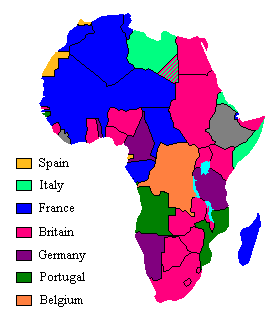
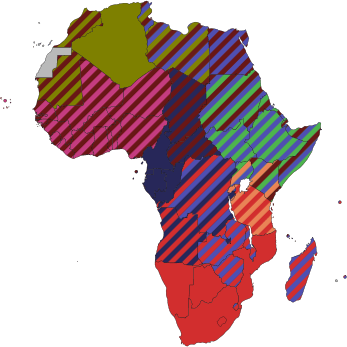
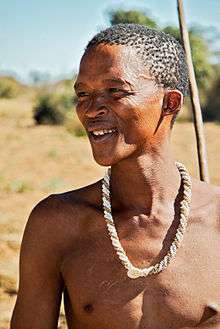
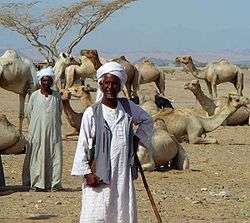

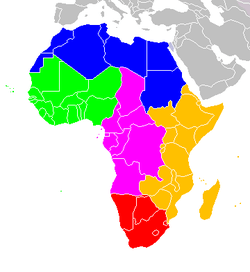
.svg.png)
.svg.png)
.svg.png)
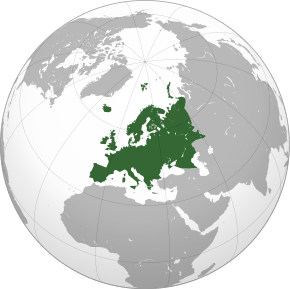
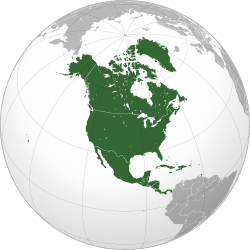
.svg.png)
_political.svg.png)
.svg.png)
.svg.png)
.svg.png)